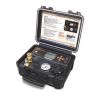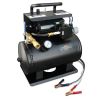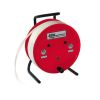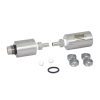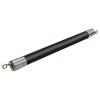Solinst Model 408 Double Valve Pumps
Features
- Positive displacement, gas drive pump provides consistent samples with excellent VOC results
- Pneumatic drive pumps are well suited for pumping contaminant liquids
- No bladder replacement is required, and provides higher pumping rates than bladder pumps
- Expedited repair and warranty service
- Lifetime technical support
- More
Overview
The Solinst Model 408 stainless steel double valve pump (DVP) is a pneumatic drive pump that allows consistent, high-quality samples. No bladder replacement is required, and the Double Valve Pump provides higher pumping rates than the Solinst Integra Bladder Pump. There is a selection of sizes and materials, variable flow rates, and it is field serviceable.
Applications
The DVP is suitable for low-flow or regular-flow sampling. The stainless steel pumps can operate to depths of 500 ft (150 m), and the PVC Double-Valve Pump can operate to depths of 100 ft (30 m). Everything is easily accessible, replaceable, and interchangeable. All components can be cleaned with mild detergent or non-phosphate soap. Pumps are not damaged by operation in sediment-laden water or dry pumping conditions.
Mechanics
Flow rates vary with the pump's depth below the surface, the depth below water level, the size of the drive and sample tubing, the drive and vent cycle times, the gas pressure applied, the aquifer recharge, and the size of the pump body.
- Solinst Model 408 Stainless Steel Double Valve Pump Specifications
- Solinst Model 408 Stainless Steel Double Valve Pump Operating Principles
- Solinst Model 408 5/8" Stainless Steel Double Valve Pump Operating Instructions
- Solinst Model 408 1.66" Stainless Steel Double Valve Pump Operating Instructions
In The News
Solinst groundwater samplers: Versatile options for a variety of applications
Groundwater sampling can be a challenging task that requires different tools for different applications. Solinst groundwater samplers offer the capability to obtain commonly needed representative samples of groundwater using different approaches of water withdrawal. Solinst’s 425 Discrete Interval Sampler uses passive sampling to grab water from a specific depth. The 407 Bladder Pump enables continuous airtight low flow sampling. The 408 Double Valve Pump can continuously sample at variable rates. “One sampler isn’t necessarily going to be for every site,” said Randy Blackburn, Solinst product manager. Each has different means of fluid sampling. The 425 sampler relies on a manual air pump that pressurizes the sampler based on the water depth.
Read MoreYSI ProQuatro Multi-Parameter Water Quality Meter Review
When environmental professionals need a reliable multi-parameter meter with measurement flexibility, the YSI ProQuatro is an affordable option. The YSI meter measures a combination of water temperature, conductivity, pH, ORP, ammonium, nitrate and chloride. [caption id="attachment_39045" align="aligncenter" width="940"] The YSI ProQuatro in use at the Fondriest Center for Environmental Studies. (Credit: Emma Jones / Fondriest Environmental) [/caption] Sensors plug into a 4-port bulkhead with an included temperature/conductivity probe. Dissolved oxygen sensors, pH and/or ORP sensors are often selected for the other ports.
Read MoreMonitoring OAE Efforts in Halifax: Fighting Climate Change with Emerging mCDR Strategies
Marine carbon dioxide (CO 2 ) removal (mCDR) is an emerging strategy that aims to fight climate change by taking advantage of the carbon capture potential of our oceans. There are multiple types of mCDR approaches being evaluated globally, one of which is ocean alkalinity enhancement (OAE). According to NOAA , OAE aims to increase the pH of water by either adding alkaline material to ocean surface waters or by removing acid from seawater. Due to the change in acidity, the chemistry of seawater changes, making it capable of absorbing greater volumes of CO 2 .
Read More
















